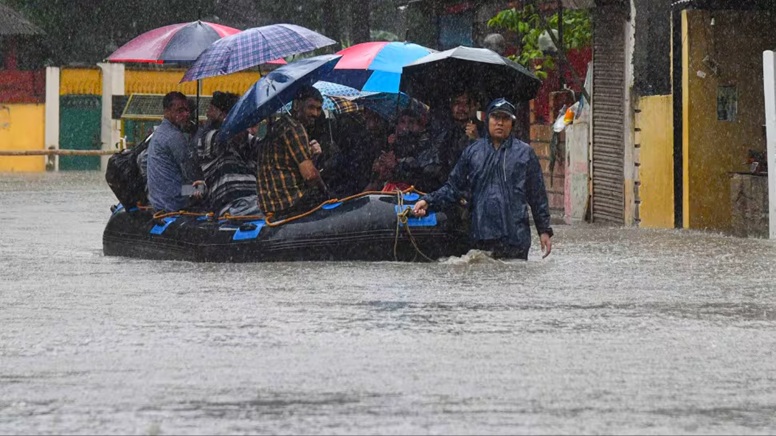Guwahati, one of the most vibrant cities in Northeast India, is once again facing the harsh impact of early monsoon rains. In May 2025, parts of the city were left waterlogged after just a short bout of heavy rainfall. Roads became rivers, power was shut down in many areas, and flights were diverted. This pattern of seasonal chaos is no longer surprising—but it is certainly avoidable.
So the question remains: Will Guwahati ever be truly rain-ready?
What’s Happening in 2025?
In the last week of May, a brief but intense rainfall event—less than 40 mm in just one day—flooded major parts of Guwahati. This included residential neighborhoods like Rukminigaon, Anil Nagar, and Hatigaon. Some areas reported water levels reaching up to the waist.
The rainwater, combined with runoff from nearby hills, overwhelmed the city's drainage systems. Local authorities had to deploy emergency services, including boats, to rescue stranded families. Several flights were rerouted to Kolkata and Agartala due to poor visibility and waterlogged runways. Public transport halted, power was cut in large zones, and thousands were affected.
Why Is Guwahati So Prone to Flooding?
1. Geography
Guwahati sits in a natural basin surrounded by hills. During heavy rainfall, water from these elevations flows rapidly into the city, adding to the volume of rainwater already on the ground.
2. Unplanned Urban Growth
In recent decades, the city has expanded rapidly—often without a sustainable development plan. Wetlands and natural drainage channels have been filled for construction. The city's capacity to absorb or redirect water has diminished significantly.
3. Choked Drains
Even the drains that do exist are often clogged with plastic, silt, and debris. Siltation from deforestation and unregulated hill cutting further reduces their efficiency.
4. Climate Change
Changing weather patterns mean that Guwahati is seeing shorter, more intense bursts of rain. These sudden downpours are difficult to manage, especially when infrastructure hasn’t been upgraded to match.
When Did This Start?
The issue of urban flooding in Guwahati has been around for decades, but it has grown noticeably worse since the early 2000s. Every monsoon, the city experiences at least a few days of severe waterlogging. Despite multiple committees and projects aimed at solving the issue, progress has been minimal and often temporary.
How Are Authorities Responding?
The Assam government has launched various projects under the "Mission Flood-Free Guwahati" umbrella. These include:
Cleaning and desilting of drains
Banning illegal hill cutting
Plans to restore blocked rivulets and wetlands
Mandatory rainwater harvesting in new buildings
Additionally, the Gauhati High Court recently asked the state government to present a detailed action plan to reduce urban flooding. However, implementation on the ground has been slow, and enforcement remains weak.
What Can Be Done Differently?
Experts suggest a multi-pronged approach:
Restore Natural Water Bodies: Wetlands must be preserved and revived as natural sponges that can absorb excess rain.
Upgrade Drainage Infrastructure: Existing drains need to be widened and cleaned regularly.
Ban Further Hill Cutting: Strict regulation and monitoring of hill slopes are essential to reduce runoff and landslides.
Adopt Smart Urban Planning: Future development must include flood-resilient architecture and sustainable land use.
Community Engagement: Public awareness campaigns can promote waste management and encourage citizen involvement in keeping drains clear.

Travel Advisory: May–June 2025
If you're planning to travel to Guwahati during the monsoon:
⚠️ Be Prepared
Monitor weather forecasts closely.
Avoid areas known for severe waterlogging.
Carry basic essentials if commuting during rainy periods.
✈️ Flight Delays Likely
Check with your airline before departure.
Guwahati airport has experienced diversions due to low visibility and water on tarmacs.
🚗 Avoid Road Travel During Heavy Rains
Many streets may become impassable even after short rainfall.
Consider rescheduling non-essential travel.
Safety Tips for Residents
Keep emergency supplies (water, food, first aid) handy.
Elevate electrical appliances to avoid water damage.
Stay indoors during peak rain hours.
Report blocked drains to municipal authorities immediately.
Avoid contact with floodwater, which may be contaminated.
Conclusion: Will Guwahati Ever Be Rain-Ready?
Becoming rain-ready is not just a government responsibility—it’s a shared civic duty. With the right mix of infrastructure upgrades, environmental conservation, strict urban regulations, and public participation, Guwahati can overcome its flood problem. But this transformation won’t happen overnight.
Until then, residents and visitors must stay alert, stay safe, and keep demanding accountability. The city’s future depends on it.
